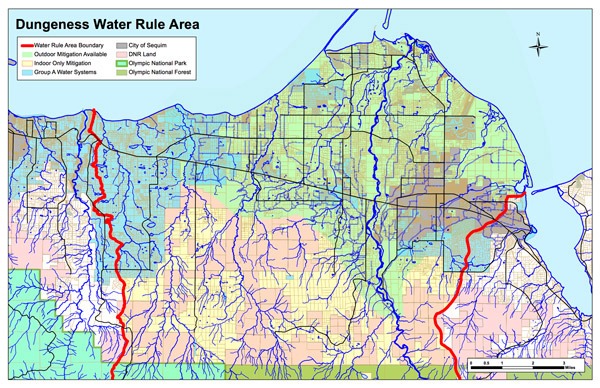The old saying “Whiskey is for drinking, water is for fighting,” attributed to Mark Twain, may be proving true in the Sequim-Dungeness Valley given a trial on the validity of the Dungeness Water Rule is set for Oct. 21 at the Thurston County Superior Court.
The trial was scheduled after Judge Gary Tabor denied the Olympic Resource Protection Council’s motion for a summary judgment, but kept the issue alive for a trial on the facts and full administrative record.
The nonprofit first challenged the Washington State Department of Ecology once it adopted the Dungeness Water Rule in early January 2013 and after a failed attempt to get state officials to work with them on a “more balanced application of the rule,” said Greg McCarry, Olympic Resource Protection Council president.
State officials designed and implemented the rule as a method for managing surface and groundwaters within the Dungeness River watershed. It seeks to ensure reliable water supplies for both drinking and to protect fish, wildlife and other in-stream resources within the watershed, which is one of 16 watersheds state officials consider “fish-critical” — basins with a shortage of water for existing needs. The rule requires mitigation of any new groundwater withdrawals within the rule area encompassing the Sequim-Dungeness Valley and the surrounding land south of Sequim, slightly west of Bagley Creek and east toward Johnson Creek.
“About 3,600 parcels are impacted by the rule,” McCarry said.
The rule area is separated into two categories: green and yellow. Within the yellow area only indoor domestic water use is permitted and no outdoor water mitigation is yet available.
To help manage the water, state officials collaborate with the Washington Water Trust — a non-regulatory, nonprofit — that acts as a water bank. The water trust issues water mitigation certificates to new water users based on mitigation and available reserves established by the Department of Ecology.
As of March, the state reported 101 water mitigation certificates have been issued.
Despite the efforts to create a rule that balances the area’s varying water demands, McCarry and roughly 500 members of the Olympic Resource Protection Council don’t agree with the in-stream flows outlined and required by the rule.
“It’s an over allocation of water to the river,” he said.
McCarry says it’s anecdotal, but the rule is having negative impacts on those wanting to buy or sell property within the Dungeness Water Rule.
“People come here and say they want to buy a piece of property and if you tell them it’s in the rule area, then all kinds of questions pop up and people avoid it,” he said. “It’s just too uncertain.”
The Peninsula Resource Protection Council has two main legal arguments it’s challenging the state on. Like when granting a water right, McCarry believes state officials should have conducted a four-part test.
“When DOE grants a water right, they have to do a four-part test and one of the legs that test is the water has to be there,” he said. “When they granted the water to the river of 180 cfs (cubic feet per second) at a time when the river flows at 90 cfs, they failed one of their requirements.”
Secondly, McCarry feels state officials should have done a Net Benefit Analysis when establishing in-stream flow requirements for the Dungeness River and its side streams.
“They’re supposed to consider humans, fish, farming and business,” he said. “But three of the net beneficiaries (humans, farming and business) in this case were kind of thrown aside.”
Although the four-part test is used when granting water rights, when setting in-stream flows the department uses standardized habitat assessment models, said Tom Loranger, Department of Ecology’s Water Resources program manager.
“What we’ve seen from most of these water cases is they tend to go beyond the Superior Court level and often times it goes onto the next court, which is the Court of Appeals,” Loranger said. “Going forward, the judge is going to hear discussions about the flows, how it was set, what science was used and how it comports with the water resources laws of the state.”
Loranger noted the rich history and several years of working with the area’s stakeholders including the City of Sequim, Clallam County, three tribes, the public utilities district and irrigators to come up with a rule that leaves enough water in the river and set aside reserves for future use.
A “significant” bill (SB 6513) recently passed by the state Legislature, demonstrates the reserves of water in the Dungeness River are consistent with Legislature’s intent, Loranger said.
“We really like that because in the case of this litigation … (the) Legislature made it very clear that people using water out of those reserves are in good shape,” he said.
For more information on the Olympic Resource Protection Council or to get involved, visit www.olympic resourcepc.org. Review the Dungeness Water Rule at www.ecy.wa.gov/laws-rules/activity/wac173518.html.



